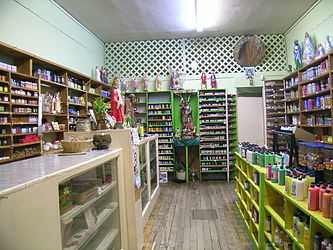Botánica

A botánica (often written botanica and less commonly known as a hierbería or botica) is a retail store that sells folk medicine, religious candles and statuary, amulets, and other products regarded as magical or as alternative medicine. They also carry oils, incense, perfumes, scented sprays (many of which are thought to have special properties) and various brand name health care products.[1]
These stores are common in many Hispanic American countries and communities of Latino people elsewhere. As such:Botánicas now can be found in any United States city that has a sizable Latino/a population, particularly those with ties to the Caribbean. The number of botánicas found outside of New York and Miami has grown tremendously in the last ten years.[2]
The name botánica is Spanish and translates as "botany" or "plant" store, referring to these establishments' function as dispensaries of medicinal herbs. Medicinal herbs may be sold dried or fresh, prepackaged or in bulk.[1][3]
Botánica almost always feature a variety of implements endemic to Roman Catholic religious practice such as rosary beads, holy water, and images of saints. Among the latter, the Virgin of Guadalupe and other devotional figures with a Latin American connection are especially well represented. In addition, most have products associated with other spiritual practices such as candomblé, curanderismo, espiritismo, macumba and santería.[1][4]
Alternative medical treatments found in botánicas are used to treat such varied conditions as arthritis, asthma, hair loss, menstrual pain and diabetes. There are also products that are designed to attract love, bring good luck and financial prosperity, deflect jealousy and so on.[1]
According to researchers at the University of Illinois at Chicago:
An article from the New York Times describes how people in San Juan, Puerto Rico turn to botánica products for protection from severe weather:Most Latin American (Latino) immigrants to the United States participate in the dominant health care system. [...] Oftentimes, while utilizing this health care system, they continue to use their own culturally appropriate health care practices [...] In curanderismo, santería, and espiritismo, the practitioners assess the patient and, depending on diagnosis, prepares a healing remedy or a variety of healing remedies. A remedy is any combination of medicinal herbs, religious amulets, and/or other products used for the prevention, treatment, or palliation of folk and somatic illnesses. It is usually administered by the practitioner and may involve several sessions. In other cases, a curandero, espiritista, or santero will provide his/her client with a list of herbs and/or religious amulets needed for the remedy. The client will go to the botánica with this "shopping list," purchase the product(s), and return to the healer for preparation and administration of the remedy. If the remedy is to be administered over a long period of time, he/she may be instructed to administer the remedy at home.[1]
Reaching for a pungent potion of solvent, wood sealer and perfume, Olga Santiago Ocana advises how to ward off bad spirits during hurricane season [...] Sandwiched between bundles of herbs, candles, beads and other paraphernalia of Santería, the Afro-Caribbean religion, Santiago tells a client to sprinkle the anti-hurricane elixir around the home. "Every time there's a hurricane, people rush to buy this", she says in her shop selling charms and potions in a region where hurricanes have shaped the local culture and psyche.[5]

In some cases, stores without a direct connection to Latin American spiritual and alternative medical practices, such as a shop catering to the practice of Vodou or to New Age beliefs, will use the term botánica as well.Botánicas serve as unique sites for the performance of religious culture. Their physical presence in an urban landscape serves as a quaint, mysterious cultural marker to those unfamiliar with their tradition and as an outpost to those who understand their purpose and seek community. Usually marked by vibrant signs (often placed on the sidewalk in front of a store) and packed from floor to ceiling with merchandise, botánicas create a highly visible cultural gathering place in the public sphere. In our ever-shrinking world, such visibility on the urban landscape can lead to an exchange of cultural ideologies and the spiritual traditions out of which they come.[2]
At the same time, new combinations of spiritual traditions are appearing. Eastern spiritualities, such as Buddhism and Hinduism, are being added to African traditions. Some botánicas sell Buddhist and Hindu statuary alongside images of the orisha.[2][3][6]
Notes
- ↑ 1.0 1.1 1.2 1.3 1.4 "The Botánica as a Culturally Appropriate Health Care Option for Latinos" by Alfredo Gomez-Beloz Ph.D., M.P.H.,1 and Noel Chavez Ph.D., R.D., L.D.2, The Journal of Alternative and Complementary Medicine Vol. 7, No. 5, 2005
- ↑ 2.0 2.1 2.2 "Botánicas: Globalization of Religion through Commodity" New York University
- ↑ 3.0 3.1 Similar stores in Brazil and the French Caribbean are called by different terms cognate with "botánica" and "hierbería". All these businesses have some parallels with shops specializing in traditional Chinese medicine and similar practices from outsides the Americas. The specifics, however, are very different.
- ↑ Botanica Obatala y Shango (Profile No.2), Research conducted by Aylen Fonseca, Monroe Community College / Harvard Pluralism Project
- ↑ "Caribbean braces for hurricane season" by Yanik Delvigne, New York Times Saturday, May 31, 2003
- ↑ An example in New Orleans
Bibliography
- Robert T. Trotter II/Trotter II, Robert T., Juan Antonio Chavira/Chavira, Juan Antonio. Curanderismo: Mexican American Folk Healing. University of Georgia Press, Second Edition, October 1997.
- Rose-Rodriguez, L., (2007) Botanicas in Connecticut: Implications for Allopathic Practitioners. Unpublished master's thesis. University of Connecticut, Storrs.
External links
| Wikimedia Commons has media related to Botánicas. |